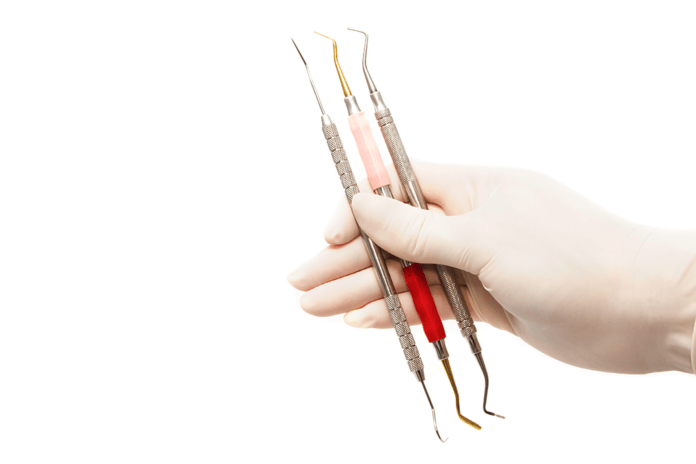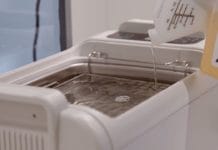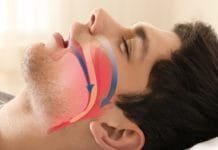Test Your Instrument Sharpness Knowledge!
Upon visual inspection of a hygiene instrument, dull cutting edges will reflect light and sharp edges will not. When a dull instrument edge is tested on an acrylic stick it will “grab” the stick.
A variety of sharpening products are available for hygienists to sharpen instruments, including both manual and automatic devices. However, to prevent over-sharpening and allow for the maximum lifespan of an instrument, it is important to understand how to evaluate blade sharpness. One way to evaluate sharpness is to conduct a visual inspection. When held under a bright light, dull instruments will reflect the light and sharp instruments will not. When using an acrylic stick to test, dull instruments will slide across the stick and sharp instruments will “grab” the stick.
Angel, M. Sharpening Periodontal Instruments. J Vet Dent. 2014; 31(1). https://doi.org/10.1177/089875641403100111
Retipping worn-out instruments is safe for the patient and clinician and has no ergonomic consequences.
Retipping dental hygiene instruments may seem like a good option due to its lower cost compared to the complete replacement of an instrument. However, there can be many consequences to both the patient and clinician of retipping.
During the retipping process, an instrument’s tip is “completely and forcibly removed from the handle through the breaking of chemical and mechanical processes of the original manufacturer adherence, and a new tip is pressed into the handle. This process involves heating and altering the original handle, and although high-quality metals are sometimes used to retip the instrument, the end product rarely meets the quality of the original piece. Therefore, no dental manufacturer in the United States will retip a dental instrument.”
A retipped instrument often has altered balance, alignment, and blade angle, which can cause ergonomic consequences to the clinician. Voids at the handle and tip junction can weaken the strength and durability which is a danger to both the clinician and patient. Further, these voids can trap ultrasonic fluid during the sterilization process thus interfering with proper and safe sterilization. Corrosion is a concern as well. Tip breakage is a huge concern as far as patient safety.
Instead of retipping, many manufacturers offer recycling or trade-in programs, and some manufacturers offer cone-socket instruments where the tip can be replaced, without forcibly removing the tip, to aid in cost reduction of replacing instruments.
Boge, E. The Rest of the Story: Dental Instrument Retipping. Today’s RDH. 2018. https://www.todaysrdh.com/the-rest-of-the-story-dental-instrument-retipping-emily-boge/
Which of the following are considered basic criteria for evaluating the sharpness of an instrument?
The importance of sharp instruments is a critical factor for every dental hygienist. Routinely using sharp instruments will improve working conditions, efficiency, quality of work, and reduce operator injury. The basic criteria for evaluating blade sharpness includes visual inspection and the use of acrylic test sticks. While the age of the instrument is also important to note, the number of strokes the instrument has completed is a better determining factor when assessing the instrument. Visual inspection can include holding the instrument under a bright light and examining the reflectivity of the cutting edge. When testing on an acrylic stick, a dull edge will slide, and a sharp edge will grab the stick.
Angel, M. Sharpening Periodontal Instruments. J Vet Dent. 2014; 31(1). https://doi.org/10.1177/089875641403100111
The average lifespan of a stainless-steel hygiene instrument is six to 18 months.
True. The average lifespan of a stainless-steel scaler or curette is six to 18 months, depending on a variety of factors such as frequency of use, how many instrument set-ups are available, difficulty of patients, etc., though the average life of instruments made with other materials may vary. In order to maximize the lifespan of a single instrument, there are a few things that hygienists can do along the way including sharpening at the first sign of dullness, developing adequate sharpening skills, and using loupes for better inspection.
Vavrosky, K. 6 Things Hygienists Wished Their Doctor/Boss Knew. Today’s RDH. 2019. https://www.todaysrdh.com/6-things-hygienists-wished-their-doctor-boss-knew/
An instrument can be used until 50% of the instrument blade length is reduced.
False. An instrument must be replaced as soon as the instrument blade is reduced by 20 percent in width or length, at which point the instrument is considered ineffective. Instruments in poor condition often fail to detect and remove calculus and reduce tactile sensitivity. Other detrimental effects include burnished calculus, increased stress on the clinician’s hands, wrists, arms, and shoulders, as well as increased work time. When using a dull instrument, the dental hygienist must use more force, increasing the risk of breaking the tip in the sulcus and “slipping” and harming the patient’s tissue.
Further, research has shown that after only 15 strokes an instrument blade begins to dull. One study showed, “after 15 strokes, nonfunctional wire edges and narrow edge deformations with bevels measuring less than 15 mu were present. After 45 strokes eight cutting edges (88.9%) showed bevels wider than 15 mu.”
Tal, H., Panno, J.M., Vaidyanathan, T.K. Scanning electron microscope evaluation of wear of dental curettes during standardized root planing. J Periodontol. 1985 Sep; 56(9):532-6. https://www.ncbi.nlm.nih.gov/pubmed/3897505












